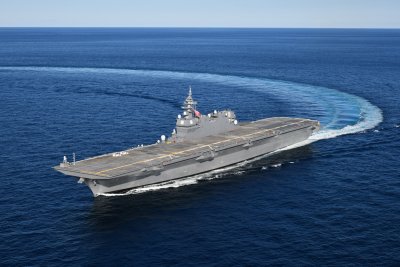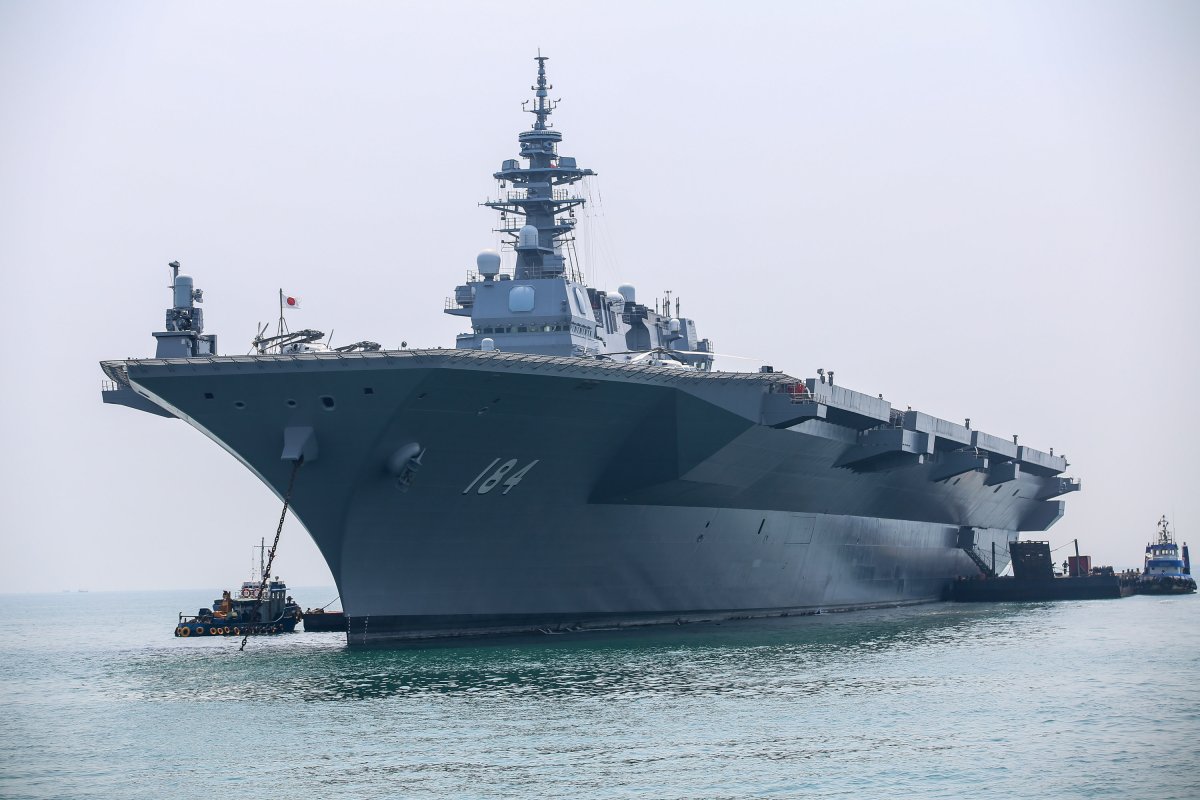Refitting of the JS Kaga, an Izumo-class warship commissioned in 2017, was completed on March 29, Tokyo said, two years after work began at the Japan Marine United shipyard in the vessel’s home port of Kure, in southwestern Hiroshima prefecture.
Images released by Japan’s Maritime Self-Defense Force over the weekend showed the Kaga‘s original trapezoidal bow converted into a rectangle, and its deck painted with new yellow markings to facilitate the operation of F-35B Lightning II stealth fighters in the near future.
Adm. Ryo Sakai, the Japanese naval service’s chief of staff, said the Kaga was scheduled to undergo tests including sea trials in the coming months, the results of which would inform planned upgrades later this year to the JS Izumo, the lead ship of the class and the first to be retrofitted for further interoperability with the United States.
1 of 2
JMSDF

JMSDF

JMSDF
Initial modifications to the Izumo began in 2021. That fall, the 800-foot, 27,000-ton warship helped prove the feasibility of the U.S.-Japan light aircraft carrier program when a U.S. Marine Corps F-35B conducted a successful short take-off and vertical landing, or STOVL, test on its deck.
Upgrades to the Izumo and the Kaga included the application of heat-resistant coating to the flight deck, with both helicopter destroyers now resembling the U.S. Navy’s Wasp- and America-class amphibious assault ships, which also operate STOVL aircraft including the F-35B.
The Kaga‘s next overhaul is scheduled for 2026. Tokyo’s defense planners want it and its sister ship to carry F-35B units by 2027.
The Japanese Defense Ministry has ordered 42 F-35Bs, in addition to 105 F-35As for its Air Self-Defense Force, making the country one of Lockheed Martin’s biggest customers.
Japan’s multiyear plan to eventually operate advanced stealth fighters at sea comes amid a surge in its defense spending, triggered by regional tensions with neighbors including North Korea but especially China, which Tokyo fears is eyeing disputed territory in the East China Sea.
Japan has also backed Ukraine against Russia, whose naval and air assets frequent the waters and skies around the Japanese archipelago.
In Japan’s defense white paper published last fall, Yasukazu Hamada, the country’s defense chief at the time, said it was “essential to make efforts to ‘defend our country by ourselves’ and increase deterrence.”
“In other words, we need to make the opponent think that ‘attacking Japan will not achieve its goals,'” he wrote in the foreword.
In a 2019 issue of Proceedings, the monthly magazine published by the U.S. Naval Institute, retired Navy officers Adm. Dennis Blair and Capt. Christopher Rodman argued Tokyo’s plans for the Izumo class would not change the ship’s primary role as a “defensive platform.”
“The challenges to defending the Self-Defense fleet against aircraft armed with cruise missiles (or hypersonic glide weapons) underscore the need to upgrade the Izumo class to operate the F-35B STOVL aircraft, as the average range of ship-killing missiles is in the hundreds of miles while the average range of defensive ship-launched anti-aircraft and anti-missile missiles is only about 100 miles,” they wrote.
“Izumo-class ships operating F-35B would be valuable in other sea-control roles as well. Armed with short-range anti-ship missiles, the F-35B would be very effective against ‘swarm tactics’ by patrol craft or maritime militia vessels. In an ‘island grab’ scenario, the F-35B would be invaluable in establishing the local air control required for Japan’s new amphibious regiment to retake remote islands,” they said.

Andrew Lotulung/NurPhoto via Getty Images
Japanese leader Fumio Kishida is in Washington, D.C., this week for a series of bilateral and multilateral meetings, beginning with a sit-down with President Joe Biden.
Together they are expected to announce a major shake-up of the U.S.-Japan security treaty that proponents say will solidify Tokyo’s long-held role as America’s most important ally in the region.
Bases throughout Japan already host the most forward-deployed American troops anywhere in the world outside of the U.S. territory—more than 50,000 personnel.
China, which has doubled down on its military maneuvers around self-ruled Taiwan, last month increased its defense budget to $231 billion—a three-decade year-on-year increase.
Beijing has voiced strong opposition to Japan’s moves to rearm. Late last month, it raised concerns about Tokyo’s intention to one day export next-generation fighter aircraft it is codeveloping with NATO members Britain and Italy.
On Tuesday, Chinese Foreign Ministry spokesperson Mao Ning urged Japan to “reflect on its history of aggression” and to “make a clean break with militarism.”
“Given Japan’s not-too-distant history of militarist aggression, Japan’s military and security moves are closely watched by its Asian neighbors and the international community,” Mao said.
China’s Defense Ministry did not immediate return a written request for comment.
Uncommon Knowledge
Newsweek is committed to challenging conventional wisdom and finding connections in the search for common ground.
Newsweek is committed to challenging conventional wisdom and finding connections in the search for common ground.


